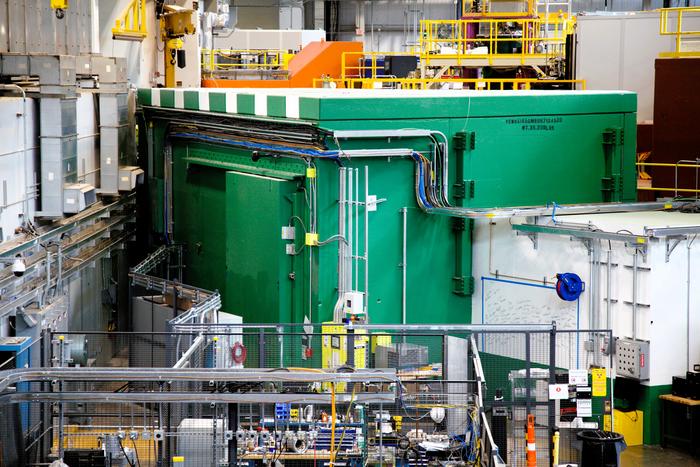The Department of Energy’s Oak Ridge National Laboratory added a new neutron scattering instrument to its powerhouse of discovery at the Spallation Neutron Source, charting new territory for neutron imaging through artificial intelligence. In July, DOE’s Office of Science approved the final commissioning of the Versatile Neutron Imaging Instrument, or VENUS.

Credit: Sumner Brown Gibbs/ORNL, U.S. Dept. of Energy
The Department of Energy’s Oak Ridge National Laboratory added a new neutron scattering instrument to its powerhouse of discovery at the Spallation Neutron Source, charting new territory for neutron imaging through artificial intelligence. In July, DOE’s Office of Science approved the final commissioning of the Versatile Neutron Imaging Instrument, or VENUS.
“It’s a dream come true,” said ORNL neutron scattering scientist Hassina Bilheux. “It has been an honor and privilege to work with so many talented people dedicated to seeing VENUS through.”
Thanks to its cutting-edge features and the world’s most intense pulsed neutron beams, VENUS will help transform research in multiple areas of science. These include energy storage for better batteries, materials science for more efficient building materials, plant physiology for drought-resistant plants and more. VENUS will help push science forward by offering high-resolution 3D imaging with enhanced contrast that is sensitive to structural details at the atomic scale. Moreover, thanks to neutrons, VENUS won’t alter the extremely delicate materials researchers bring to ORNL for study.
In addition, VENUS will feature advanced computational methods that make the most of neutron beam time. During experiments, VENUS’s instrument scientists and users will use AI to produce 3D models of samples from time-of-flight raw data in significantly fewer measurements. Instead of experimenters waiting days or even weeks for 3D models of their samples from multiple radiographs, or images of internal form, research teams will have what they came for by the time they wrap up their experiments.
“VENUS offers broad capabilities for access to unique contrasts from many fields in science,” Bilheux said. “And with the help of AI, researchers can get their 3D data as soon as the experiment is over.”
VENUS also provides a platform for the United States to take a leadership role in the developing field of neutron imaging.
“We are thrilled to offer such one-of-a-kind capabilities to user communities around the globe,” said Jens Dilling, associate laboratory director for ORNL’s Neutron Sciences Directorate. “Considering some of the challenges we face as a nation and around the world, science and the talented people who make it happen, as here at VENUS, might be our greatest hope.”
The journey toward VENUS began in 2006 when Bilheux conceived an idea to create a neutron scattering instrument with enhanced imaging contrast for studying crystalline and amorphous samples at the atomic scale without damaging them. As an example, a NASA researcher, assisted by ORNL instrument scientists on the MARS beamline at ORNL’s High Flux Isotope Reactor, or HFIR, used neutrons to study extremely fragile moon rocks from Apollo missions. Together, NASA and the MARS team produced a high-resolution virtual rendering of the rocks to complement later measurements at VENUS. In the future, VENUS will help researchers understand the mineral content in the rocks for clues about early planetary formations and where we might find water on the moon.
No other research technique can nondestructively produce such results in 3D with precise information on atomic structure. Neutrons accomplish this because they pass easily through materials without damaging them. Neutron imaging scientists can probe thick samples, generate 3D images and build more complete microscale models of materials based on how neutrons scatter, or bounce, off atoms.
Efforts to use AI with ORNL’s beamlines began in recent years with the development of advanced algorithms that acquire data intelligently, autonomously and quickly. Working in collaboration with X-ray beamline teams at Brookhaven National Laboratory’s National Synchrotron Light Source II and Purdue University, ORNL’s SNAP neutron imaging beamline team published their latest results in Nature Publishing Group’s Scientific Reports, providing algorithms that form the basis for VENUS’s AI.
“We’re very thankful for collaborating with our X-ray colleagues on this AI project,” Bilheux said. “This partnership helped set the stage for high-quality research results we expect will be game-changing in materials science.”
ORNL also formed a VENUS Advisory Committee that has remained involved since the construction project began. Physical construction for VENUS started in 2019, continued through the pandemic years, entered final phases in late 2023 and nears completion with plans for user beamtime beginning the last half of 2025.
“It takes a village to create such a complex instrument, and our entire ORNL team is very dedicated, which I’m very thankful for and very proud of,” Bilheux said. “Now she’s ready — it’s time to come try things and push the limits of the instrument.”
SNS and HFIR are DOE Office of Science user facilities.
UT-Battelle manages ORNL for the DOE Office of Science, the single largest supporter of basic research in the physical sciences in the United States. The Office of Science is working to address some of the most pressing challenges of our time. For more information, please visit energy.gov/science. — Sumner Brown Gibbs
Method of Research
Imaging analysis
Subject of Research
Not applicable



